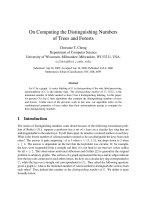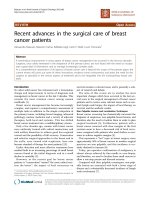Common ground in the transcriptional profiles of wounds and tumors pps
Bạn đang xem bản rút gọn của tài liệu. Xem và tải ngay bản đầy đủ của tài liệu tại đây (56.32 KB, 3 trang )
Genome Biology 2004, 5:228
comment
reviews
reports deposited research
interactions
information
refereed research
Minireview
Common ground in the transcriptional profiles of wounds and tumors
Richard Grose
Address: Cancer Research UK London Research Institute, 61 Lincoln’s Inn Fields, London WC2A 3PX, UK. E-mail:
Abstract
Healing wounds and developing tumors are both sites of dynamic interactions between a variety
of cell types. Recent microarray studies comparing wounds and tumors have identified
characteristic similarities in gene expression that may prove to be useful for assessing cancer
prognosis and for choosing subsequent treatment.
Published: 26 May 2004
Genome Biology 2004, 5:228
The electronic version of this article is the complete one and can be
found online at />© 2004 BioMed Central Ltd
Tumors have long been described as sharing many histological
features with repairing tissues, an idea that likens them to
wounds that do not heal [1]. Such an analogy is tempting, as
in both cases cell proliferation, survival and migration - in
response to a cocktail of growth factors and cytokines - is
accompanied by an inflammatory and angiogenic response
[2]. Signals facilitating survival and invasion come from
many sources in the tumor environment, with tumor cells,
fibroblasts and endothelial cells producing various growth
and differentiation factors, extracellular matrix proteins and
proteases. These signals, together with other factors such as
signaling mediated by cell-cell and cell-matrix interactions,
activate a wide range of intracellular signaling cascades to
affect cell motility and survival [3]. At a wound site, various
cell types release the same growth factors and proteases,
activating similar downstream signaling pathways [4].
Microarray analysis allows the screening of thousands of genes
without a prior knowledge of, or bias for, which genes might be
involved in the process being studied. It also allows the identifi-
cation of panels of genes rather than individual ones, which
may give a more complete picture of the process under investi-
gation. Recent data have strengthened the link between tumors
and wounds by providing molecular evidence of similar gene-
expression profiles in keratinocytes at the wound margin and
in squamous cell carcinoma [5]. Most recently, microarray
studies using an in vitro model of the wound environment have
identified a transcriptional signature for stromal fibroblasts,
which may prove to be a useful clinical tool in assessing the
stage of tumor progression [6].
Gene-expression profiling in a wound model
In pioneering work five years ago, the Brown lab used a DNA
microarray approach to profile the genetic response of
fibroblasts to serum, a fluid to which they should only be
exposed in the context of a healing wound [7]. Accordingly,
the spectrum of genes whose expression was upregulated
included many whose products are implicated in key steps
during wound repair - hemostasis, proliferation, migration,
inflammation and angiogenesis - and many of these genes
were subsequently identified in microarray-based searches
for wounding-regulated genes [8,9]. In pursuing this line of
research further, the Brown lab has recently used a broader
approach to identify a canonical gene-expression signature
of the response of fibroblasts to serum, and compared this
with the publicly available mRNA expression profiles of a
range of tumor and control tissue samples [6]. These
genome-scale studies have again highlighted the similarities
between wound repair and tumorigenesis, and suggest that
the closer the match between a tumor’s expression profile
and a core set of genes induced by wounding, the worse the
outcome for the cancer patient.
In a comprehensive study, Chang and co-workers [6] isolated
fibroblasts from ten different anatomical sites and analyzed
their transcriptional response following exposure to serum.
Quantitating the expression of 36,000 human genes, they iden-
tified a common group of 677 genes that were either up- or
downregulated by at least 1.5-fold in all populations. These
were further pared down to a core of 512 genes whose expres-
sion was both serum-responsive and cell-cycle-independent;
this set of genes was defined as the fibroblast core serum
response. Reasoning that the only place that fibroblasts are
exposed to serum in vivo is where the tissue is undergoing
repair or remodeling, the authors argue that the expression of
core serum response genes in tumors may provide insight into
the extent to which wound repair recapitulates tumorigenesis.
Epithelial migration and squamous cell
carcinoma
Initial studies using laser capture microdissection to isolate
cells, followed by microarrays to compare gene expression in
oral squamous cell carcinoma and normal epithelium sug-
gested that such a ‘clean’ approach might reveal changes in
gene expression in malignancy [10]. In a further study from
the same group, a similar approach was used to identify
keratinocyte genes expressed in response to wounding;
this study found that the transient changes that keratino-
cytes undergo during repair - hyperproliferation, migration
and invasion - phenotypically resemble the response of
keratinocytes during malignant transformation in squamous
cell carcinoma [5]. Again using laser capture microdissection
to isolate cells, mRNA was isolated from keratinocytes of
the wound-edge hyperproliferative epithelium and from
keratinocytes of unwounded epidermis. By hybridizing
cDNA made from both populations to cDNA arrays, Pedersen
et al. [5] identified 58 genes specifically expressed in the
hyperproliferative epithelium during the repair process, of
which more than a third were also expressed in squamous cell
carcinoma. Where differences in gene expression were seen
between wound healing and the carcinoma, they could be
associated with the loss of growth control and the invasive-
ness that distinguishes malignant keratinocytes from wound-
edge keratinocytes. Thus, in this study [5], it seems that while
there are clear similarities between the gene-expression
profiles of wound-margin keratinocytes and squamous cell
carcinoma keratinocytes, the similarity decreases as the carci-
noma keratinocytes become more malignant. This apparent
difference may be because the keratinocytes covering a
wound undergo transient changes to a migratory phenotype,
whereas in squamous cell carcinomas the changes form part
of a permanent and more aggressive progression.
Interestingly, comparison of the fibroblast signature with
the expression profiles of various carcinomas (epithelial-
derived tumors) revealed that the more the tumor signature
resembles the fibroblast core serum response, the more
likely the tumor cells are to metastasize, and thus the worse
the prognosis is for the patient [6]. One explanation for this
might be the occurrence of an epithelial-to-mesenchymal
transition within the tumor. This would be likely to result in
the upregulation of genes expressed more commonly in
fibroblasts than in epithelia, and hence provide a link
between the extent to which the epithelial-mesenchymal
transition has occurred and the fibroblast core serum
response. Thus it would be interesting to compare the results
of Chang and co-workers [6] with expression-profiling data
which described a set of genes specifically regulated during
an epithelial-mesenchymal transition [11]. An intriguing
possibility is that wound healing is accompanied by acute
cell migration, invasion and proliferation caused by short-
term signals, whereas long-term activation of the same
signals might cause the irreversible progression towards
epithelial-mesenchymal transition [12].
Predicting cancer progression
The concept that prolonged exposure to ‘wound’ signals at
the tumor site causes cancer progression may be further sup-
ported by recent findings that challenge the dogma that
metastases arise from a relatively small population of cells
within a tumor that have a particularly high metastatic
potential. Rather, microarray studies comparing metastatic
and non-metastatic adenocarcinomas identified a molecular
signature correlating with metastasis, and suggested that the
bulk of cells within the tumor share this signature, and thus
the metastatic potential is encoded within the bulk of the
primary tumor [13]. This signature, defined as 17 differen-
tially regulated genes, correlated with metastatic potential in
solid tumors from a variety of organs, supporting the
concept of a common pathway towards metastasis, and sug-
gesting the existence of common therapeutic targets in dif-
ferent cancers.
Gene-expression profiling has also been reported to be
useful for predicting the clinical outcome of breast cancer
[14]. DNA microarray analysis of primary breast tumors
from 117 patients revealed a ‘poor prognosis’ gene-expres-
sion signature, consisting of genes regulating the cell cycle,
invasion, metastasis and angiogenesis. Signatures such as
these can then be used in patient screening to select those
patients who would benefit from receiving chemotherapy or
hormonal therapy that reduces the risk of distant metastases
three-fold but provides no benefit for the majority of
patients receiving it. Thus many patients could be spared the
harmful side effects of a non-beneficial therapy.
Understanding repair and identifying targets
Harnessing the power of microarray technology to provide
reliable insight into clinically significant problems, including
wound repair and tumorigenesis, presents a potentially attrac-
tive aid in deciding on the appropriate treatment. Thus far the
use of microarrays in predicting cancer outcomes has shown
variable prognostic performance, however, and one slight
concern is that a publication bias towards positive studies may
exaggerate the power of gene-expression profiling [15]. Key to
the future application of microarrays as a prognostic tool will
be the rigorous design of larger studies with complete cross-
validation of results, such as that shown when comparing the
core serum response with tumor signatures from independent
studies of a variety of adenocarcinomas [6,13,14].
228.2 Genome Biology 2004, Volume 5, Issue 6, Article 228 Grose />Genome Biology 2004, 5:228
As microarray technology becomes more widely available,
we can hope to see a vast growth in the understanding of the
signaling events that control the wound-repair process. Given
the similarities between wound repair and tumorigenesis,
novel findings in the wound-repair field may help to identify
new targets for cancer therapy. Tantalizingly, small-molecule
drugs, such as non-steroidal anti-inflammatory agents and
imatinib mesylate, which target cyclooxygenase-2 [16] and
platelet-derived growth factor, respectively [17], are effica-
cious in treating or preventing cancer. Since both cyclooxy-
genase-2 and platelet-derived growth factor are key proteins
in the response of fibroblasts to serum, it is tempting to
speculate that as we learn more of the global genetic
response to wounding, we may identify valuable targets for
therapeutic intervention.
Acknowledgements
I am extremely grateful to Sabine Werner and Clive Dickson for critical
reading of this manuscript and to Cancer Research UK for funding.
References
1. Dvorak HF: Tumors: wounds that do not heal. Similarities
between tumor stroma generation and wound healing.
N Engl J Med 1986, 315:1650-1659.
2. Bissell MJ, Radisky D: Putting tumours in context. Nat Rev Cancer
2001, 1:46-54.
3. Liotta LA, Kohn EC: The microenvironment of the tumour-
host interface. Nature 2001, 411:375-379.
4. Werner S, Grose R: Regulation of wound healing by growth
factors and cytokines. Physiol Rev 2003, 83:835-870.
5. Pedersen TX, Leethanakul C, Patel V, Mitola D, Lund LR, Dano K,
Johnsen M, Gutkind JS, Bugge TH: Laser capture microdissec-
tion-based in vivo genomic profiling of wound keratinocytes
identifies similarities and differences to squamous cell carci-
noma. Oncogene 2003, 22:3964-3976.
6. Chang HY, Sneddon JB, Alizadeh AA, Sood R, West RB, Mont-
gomery K, Chi JT, van de Rijn M, Botstein D, Brown PO: Gene
expression signature of fibroblast serum response predicts
human cancer progression: similarities between tumors and
wounds. PLoS Biol 2004, 2:E7.
7. Iyer VR, Eisen MB, Ross DT, Schuler G, Moore T, Lee JC, Trent JM,
Staudt LM, Hudson J Jr, Boguski MS, et al.: The transcriptional
program in the response of human fibroblasts to serum.
Science 1999, 283:83-87.
8. Thorey IS, Roth J, Regenbogen J, Halle JP, Bittner M, Vogl T, Kaesler
S, Bugnon P, Reitmaier B, Durka S, et al.: The Ca
2+
-binding pro-
teins S100A8 and S100A9 are encoded by novel injury-regu-
lated genes. J Biol Chem 2001, 276:35818-35825.
9. Cole J, Tsou R, Wallace K, Gibran N, Isik F: Early gene expres-
sion profile of human skin to injury using high-density cDNA
microarrays. Wound Repair Regen 2001, 9:360-370.
10. Leethanakul C, Patel V, Gillespie J, Pallente M, Ensley JF, Koon-
tongkaew S, Liotta LA, Emmert-Buck M, Gutkind JS: Distinct
pattern of expression of differentiation and growth-related
genes in squamous cell carcinomas of the head and neck
revealed by the use of laser capture microdissection and
cDNA arrays. Oncogene 2000, 19:3220-3224.
11. Jechlinger M, Grunert S, Tamir IH, Janda E, Ludemann S, Waerner T,
Seither P, Weith A, Beug H, Kraut N: Expression profiling of
epithelial plasticity in tumor progression. Oncogene 2003,
22:7155-7169.
12. Grunert S, Jechlinger M, Beug H: Diverse cellular and molecular
mechanisms contribute to epithelial plasticity and metasta-
sis. Nat Rev Mol Cell Biol 2003, 4:657-665.
13. Ramaswamy S, Ross KN, Lander ES, Golub TR: A molecular signa-
ture of metastasis in primary solid tumors. Nat Genet 2003,
33:49-54.
14. van ‘t Veer LJ, Dai H, van de Vijver MJ, He YD, Hart AA, Mao M,
Peterse HL, van der Kooy K, Marton MJ, Witteveen AT, et al.: Gene
expression profiling predicts clinical outcome of breast
cancer. Nature 2002, 415:530-536.
15. Ntzani EE, Ioannidis JP: Predictive ability of DNA microarrays
for cancer outcomes and correlates: an empirical assess-
ment. Lancet 2003, 362:1439-1444.
16. Huls G, Koornstra JJ, Kleibeuker JH: Non-steroidal anti-inflam-
matory drugs and molecular carcinogenesis of colorectal
carcinomas. Lancet 2003, 362:230-232.
17. Bergers G, Song S, Meyer-Morse N, Bergsland E, Hanahan D: Bene-
fits of targeting both pericytes and endothelial cells in the
tumor vasculature with kinase inhibitors. J Clin Invest 2003,
111:1287-1295.
comment
reviews
reports deposited research
interactions
information
refereed research
Genome Biology 2004, Volume 5, Issue 6, Article 228 Grose 228.3
Genome Biology 2004, 5:228









